Jiayi Guo
ENAT: Rethinking Spatial-temporal Interactions in Token-based Image Synthesis
Nov 11, 2024



Abstract:Recently, token-based generation have demonstrated their effectiveness in image synthesis. As a representative example, non-autoregressive Transformers (NATs) can generate decent-quality images in a few steps. NATs perform generation in a progressive manner, where the latent tokens of a resulting image are incrementally revealed. At each step, the unrevealed image regions are padded with mask tokens and inferred by NAT. In this paper, we delve into the mechanisms behind the effectiveness of NATs and uncover two important patterns that naturally emerge from NATs: Spatially (within a step), although mask and visible tokens are processed uniformly by NATs, the interactions between them are highly asymmetric. In specific, mask tokens mainly gather information for decoding, while visible tokens tend to primarily provide information, and their deep representations can be built only upon themselves. Temporally (across steps), the interactions between adjacent generation steps mostly concentrate on updating the representations of a few critical tokens, while the computation for the majority of tokens is generally repetitive. Driven by these findings, we propose EfficientNAT (ENAT), a NAT model that explicitly encourages these critical interactions inherent in NATs. At the spatial level, we disentangle the computations of visible and mask tokens by encoding visible tokens independently, while decoding mask tokens conditioned on the fully encoded visible tokens. At the temporal level, we prioritize the computation of the critical tokens at each step, while maximally reusing previously computed token representations to supplement necessary information. ENAT improves the performance of NATs notably with significantly reduced computational cost. Experiments on ImageNet-256, ImageNet-512 and MS-COCO validate the effectiveness of ENAT. Code is available at https://github.com/LeapLabTHU/ENAT.
Taming Rectified Flow for Inversion and Editing
Nov 07, 2024



Abstract:Rectified-flow-based diffusion transformers, such as FLUX and OpenSora, have demonstrated exceptional performance in the field of image and video generation. Despite their robust generative capabilities, these models often suffer from inaccurate inversion, which could further limit their effectiveness in downstream tasks such as image and video editing. To address this issue, we propose RF-Solver, a novel training-free sampler that enhances inversion precision by reducing errors in the process of solving rectified flow ODEs. Specifically, we derive the exact formulation of the rectified flow ODE and perform a high-order Taylor expansion to estimate its nonlinear components, significantly decreasing the approximation error at each timestep. Building upon RF-Solver, we further design RF-Edit, which comprises specialized sub-modules for image and video editing. By sharing self-attention layer features during the editing process, RF-Edit effectively preserves the structural information of the source image or video while achieving high-quality editing results. Our approach is compatible with any pre-trained rectified-flow-based models for image and video tasks, requiring no additional training or optimization. Extensive experiments on text-to-image generation, image & video inversion, and image & video editing demonstrate the robust performance and adaptability of our methods. Code is available at https://github.com/wangjiangshan0725/RF-Solver-Edit.
UniAutoML: A Human-Centered Framework for Unified Discriminative and Generative AutoML with Large Language Models
Oct 09, 2024



Abstract:Automated Machine Learning (AutoML) has simplified complex ML processes such as data pre-processing, model selection, and hyper-parameter searching. However, traditional AutoML frameworks focus solely on discriminative tasks, often falling short in tackling AutoML for generative models. Additionally, these frameworks lack interpretability and user engagement during the training process, primarily due to the absence of human-centered design. It leads to a lack of transparency in final decision-making and limited user control, potentially reducing trust and adoption of AutoML methods. To address these limitations, we introduce UniAutoML, a human-centered AutoML framework that leverages Large Language Models (LLMs) to unify AutoML for both discriminative (e.g., Transformers and CNNs for classification or regression tasks) and generative tasks (e.g., fine-tuning diffusion models or LLMs). The human-centered design of UniAutoML innovatively features a conversational user interface (CUI) that facilitates natural language interactions, providing users with real-time guidance, feedback, and progress updates for better interpretability. This design enhances transparency and user control throughout the AutoML training process, allowing users to seamlessly break down or modify the model being trained. To mitigate potential risks associated with LLM generated content, UniAutoML incorporates a safety guardline that filters inputs and censors outputs. We evaluated UniAutoML's performance and usability through experiments on eight diverse datasets and user studies involving 25 participants, demonstrating that UniAutoML not only enhances performance but also improves user control and trust. Our human-centered design bridges the gap between AutoML capabilities and user understanding, making ML more accessible to a broader audience.
AdaNAT: Exploring Adaptive Policy for Token-Based Image Generation
Aug 31, 2024



Abstract:Recent studies have demonstrated the effectiveness of token-based methods for visual content generation. As a representative work, non-autoregressive Transformers (NATs) are able to synthesize images with decent quality in a small number of steps. However, NATs usually necessitate configuring a complicated generation policy comprising multiple manually-designed scheduling rules. These heuristic-driven rules are prone to sub-optimality and come with the requirements of expert knowledge and labor-intensive efforts. Moreover, their one-size-fits-all nature cannot flexibly adapt to the diverse characteristics of each individual sample. To address these issues, we propose AdaNAT, a learnable approach that automatically configures a suitable policy tailored for every sample to be generated. In specific, we formulate the determination of generation policies as a Markov decision process. Under this framework, a lightweight policy network for generation can be learned via reinforcement learning. Importantly, we demonstrate that simple reward designs such as FID or pre-trained reward models, may not reliably guarantee the desired quality or diversity of generated samples. Therefore, we propose an adversarial reward design to guide the training of policy networks effectively. Comprehensive experiments on four benchmark datasets, i.e., ImageNet-256 & 512, MS-COCO, and CC3M, validate the effectiveness of AdaNAT. Code and pre-trained models will be released at https://github.com/LeapLabTHU/AdaNAT.
On the KL-Divergence-based Robust Satisficing Model
Aug 17, 2024



Abstract:Empirical risk minimization, a cornerstone in machine learning, is often hindered by the Optimizer's Curse stemming from discrepancies between the empirical and true data-generating distributions.To address this challenge, the robust satisficing framework has emerged recently to mitigate ambiguity in the true distribution. Distinguished by its interpretable hyperparameter and enhanced performance guarantees, this approach has attracted increasing attention from academia. However, its applicability in tackling general machine learning problems, notably deep neural networks, remains largely unexplored due to the computational challenges in solving this model efficiently across general loss functions. In this study, we delve into the Kullback Leibler divergence based robust satisficing model under a general loss function, presenting analytical interpretations, diverse performance guarantees, efficient and stable numerical methods, convergence analysis, and an extension tailored for hierarchical data structures. Through extensive numerical experiments across three distinct machine learning tasks, we demonstrate the superior performance of our model compared to state-of-the-art benchmarks.
Efficient Diffusion Transformer with Step-wise Dynamic Attention Mediators
Aug 11, 2024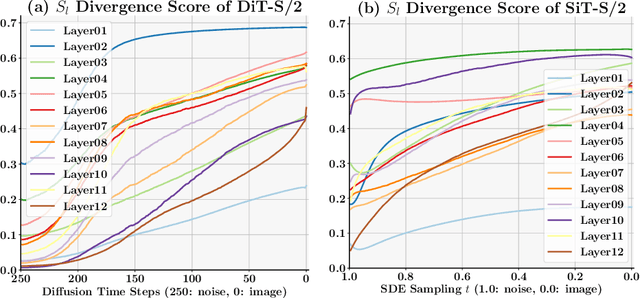

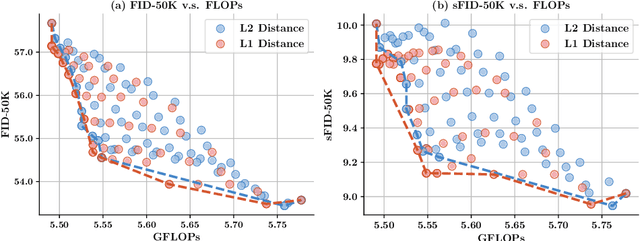
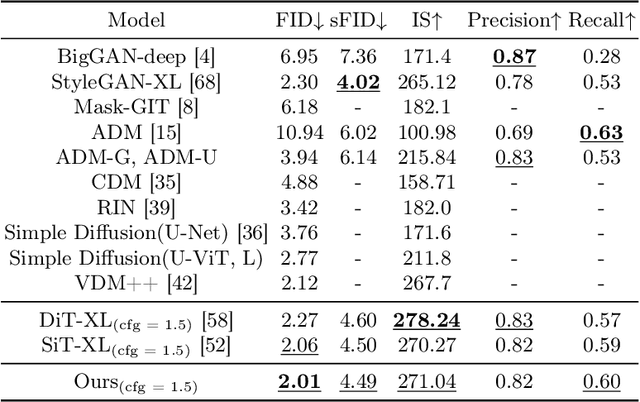
Abstract:This paper identifies significant redundancy in the query-key interactions within self-attention mechanisms of diffusion transformer models, particularly during the early stages of denoising diffusion steps. In response to this observation, we present a novel diffusion transformer framework incorporating an additional set of mediator tokens to engage with queries and keys separately. By modulating the number of mediator tokens during the denoising generation phases, our model initiates the denoising process with a precise, non-ambiguous stage and gradually transitions to a phase enriched with detail. Concurrently, integrating mediator tokens simplifies the attention module's complexity to a linear scale, enhancing the efficiency of global attention processes. Additionally, we propose a time-step dynamic mediator token adjustment mechanism that further decreases the required computational FLOPs for generation, simultaneously facilitating the generation of high-quality images within the constraints of varied inference budgets. Extensive experiments demonstrate that the proposed method can improve the generated image quality while also reducing the inference cost of diffusion transformers. When integrated with the recent work SiT, our method achieves a state-of-the-art FID score of 2.01. The source code is available at https://github.com/LeapLabTHU/Attention-Mediators.
UniTTA: Unified Benchmark and Versatile Framework Towards Realistic Test-Time Adaptation
Jul 29, 2024

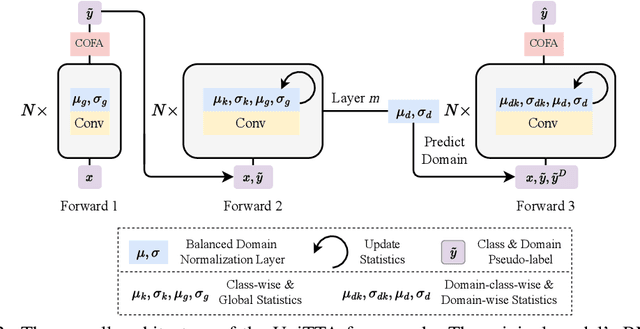
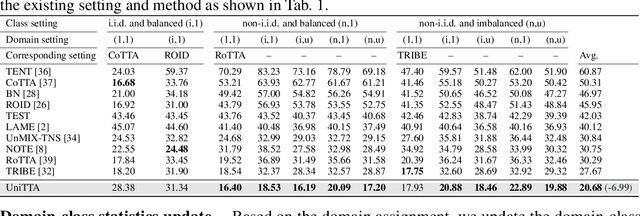
Abstract:Test-Time Adaptation (TTA) aims to adapt pre-trained models to the target domain during testing. In reality, this adaptability can be influenced by multiple factors. Researchers have identified various challenging scenarios and developed diverse methods to address these challenges, such as dealing with continual domain shifts, mixed domains, and temporally correlated or imbalanced class distributions. Despite these efforts, a unified and comprehensive benchmark has yet to be established. To this end, we propose a Unified Test-Time Adaptation (UniTTA) benchmark, which is comprehensive and widely applicable. Each scenario within the benchmark is fully described by a Markov state transition matrix for sampling from the original dataset. The UniTTA benchmark considers both domain and class as two independent dimensions of data and addresses various combinations of imbalance/balance and i.i.d./non-i.i.d./continual conditions, covering a total of \( (2 \times 3)^2 = 36 \) scenarios. It establishes a comprehensive evaluation benchmark for realistic TTA and provides a guideline for practitioners to select the most suitable TTA method. Alongside this benchmark, we propose a versatile UniTTA framework, which includes a Balanced Domain Normalization (BDN) layer and a COrrelated Feature Adaptation (COFA) method--designed to mitigate distribution gaps in domain and class, respectively. Extensive experiments demonstrate that our UniTTA framework excels within the UniTTA benchmark and achieves state-of-the-art performance on average. Our code is available at \url{https://github.com/LeapLabTHU/UniTTA}.
COVE: Unleashing the Diffusion Feature Correspondence for Consistent Video Editing
Jun 13, 2024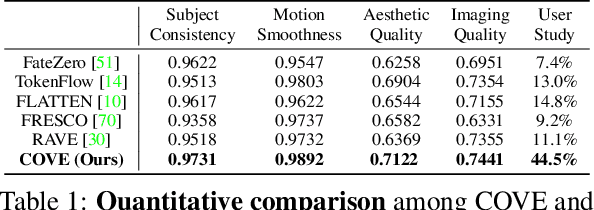
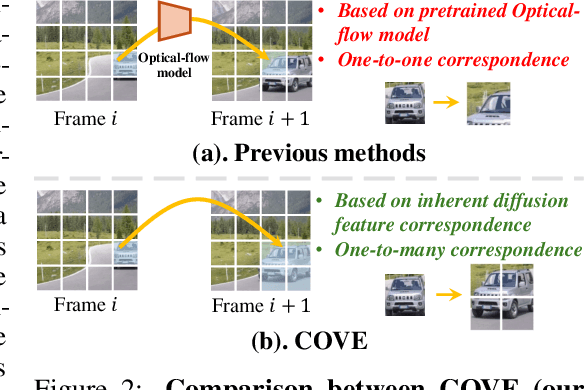

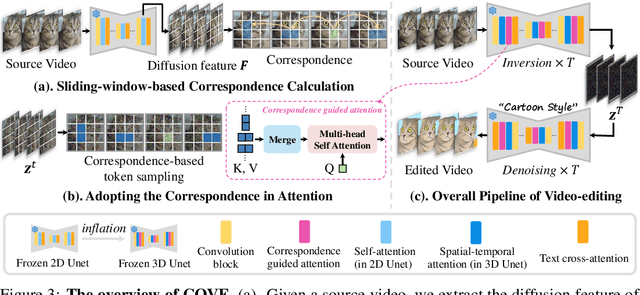
Abstract:Video editing is an emerging task, in which most current methods adopt the pre-trained text-to-image (T2I) diffusion model to edit the source video in a zero-shot manner. Despite extensive efforts, maintaining the temporal consistency of edited videos remains challenging due to the lack of temporal constraints in the regular T2I diffusion model. To address this issue, we propose COrrespondence-guided Video Editing (COVE), leveraging the inherent diffusion feature correspondence to achieve high-quality and consistent video editing. Specifically, we propose an efficient sliding-window-based strategy to calculate the similarity among tokens in the diffusion features of source videos, identifying the tokens with high correspondence across frames. During the inversion and denoising process, we sample the tokens in noisy latent based on the correspondence and then perform self-attention within them. To save GPU memory usage and accelerate the editing process, we further introduce the temporal-dimensional token merging strategy, which can effectively reduce redundancy. COVE can be seamlessly integrated into the pre-trained T2I diffusion model without the need for extra training or optimization. Extensive experiment results demonstrate that COVE achieves the start-of-the-art performance in various video editing scenarios, outperforming existing methods both quantitatively and qualitatively. The code will be release at https://github.com/wangjiangshan0725/COVE
Revisiting Non-Autoregressive Transformers for Efficient Image Synthesis
Jun 08, 2024



Abstract:The field of image synthesis is currently flourishing due to the advancements in diffusion models. While diffusion models have been successful, their computational intensity has prompted the pursuit of more efficient alternatives. As a representative work, non-autoregressive Transformers (NATs) have been recognized for their rapid generation. However, a major drawback of these models is their inferior performance compared to diffusion models. In this paper, we aim to re-evaluate the full potential of NATs by revisiting the design of their training and inference strategies. Specifically, we identify the complexities in properly configuring these strategies and indicate the possible sub-optimality in existing heuristic-driven designs. Recognizing this, we propose to go beyond existing methods by directly solving the optimal strategies in an automatic framework. The resulting method, named AutoNAT, advances the performance boundaries of NATs notably, and is able to perform comparably with the latest diffusion models at a significantly reduced inference cost. The effectiveness of AutoNAT is validated on four benchmark datasets, i.e., ImageNet-256 & 512, MS-COCO, and CC3M. Our code is available at https://github.com/LeapLabTHU/ImprovedNAT.
Everything to the Synthetic: Diffusion-driven Test-time Adaptation via Synthetic-Domain Alignment
Jun 06, 2024



Abstract:Test-time adaptation (TTA) aims to enhance the performance of source-domain pretrained models when tested on unknown shifted target domains. Traditional TTA methods primarily adapt model weights based on target data streams, making model performance sensitive to the amount and order of target data. Recently, diffusion-driven TTA methods have demonstrated strong performance by using an unconditional diffusion model, which is also trained on the source domain to transform target data into synthetic data as a source domain projection. This allows the source model to make predictions without weight adaptation. In this paper, we argue that the domains of the source model and the synthetic data in diffusion-driven TTA methods are not aligned. To adapt the source model to the synthetic domain of the unconditional diffusion model, we introduce a Synthetic-Domain Alignment (SDA) framework to fine-tune the source model with synthetic data. Specifically, we first employ a conditional diffusion model to generate labeled samples, creating a synthetic dataset. Subsequently, we use the aforementioned unconditional diffusion model to add noise to and denoise each sample before fine-tuning. This process mitigates the potential domain gap between the conditional and unconditional models. Extensive experiments across various models and benchmarks demonstrate that SDA achieves superior domain alignment and consistently outperforms existing diffusion-driven TTA methods. Our code is available at https://github.com/SHI-Labs/Diffusion-Driven-Test-Time-Adaptation-via-Synthetic-Domain-Alignment.
 Add to Chrome
Add to Chrome Add to Firefox
Add to Firefox Add to Edge
Add to Edge